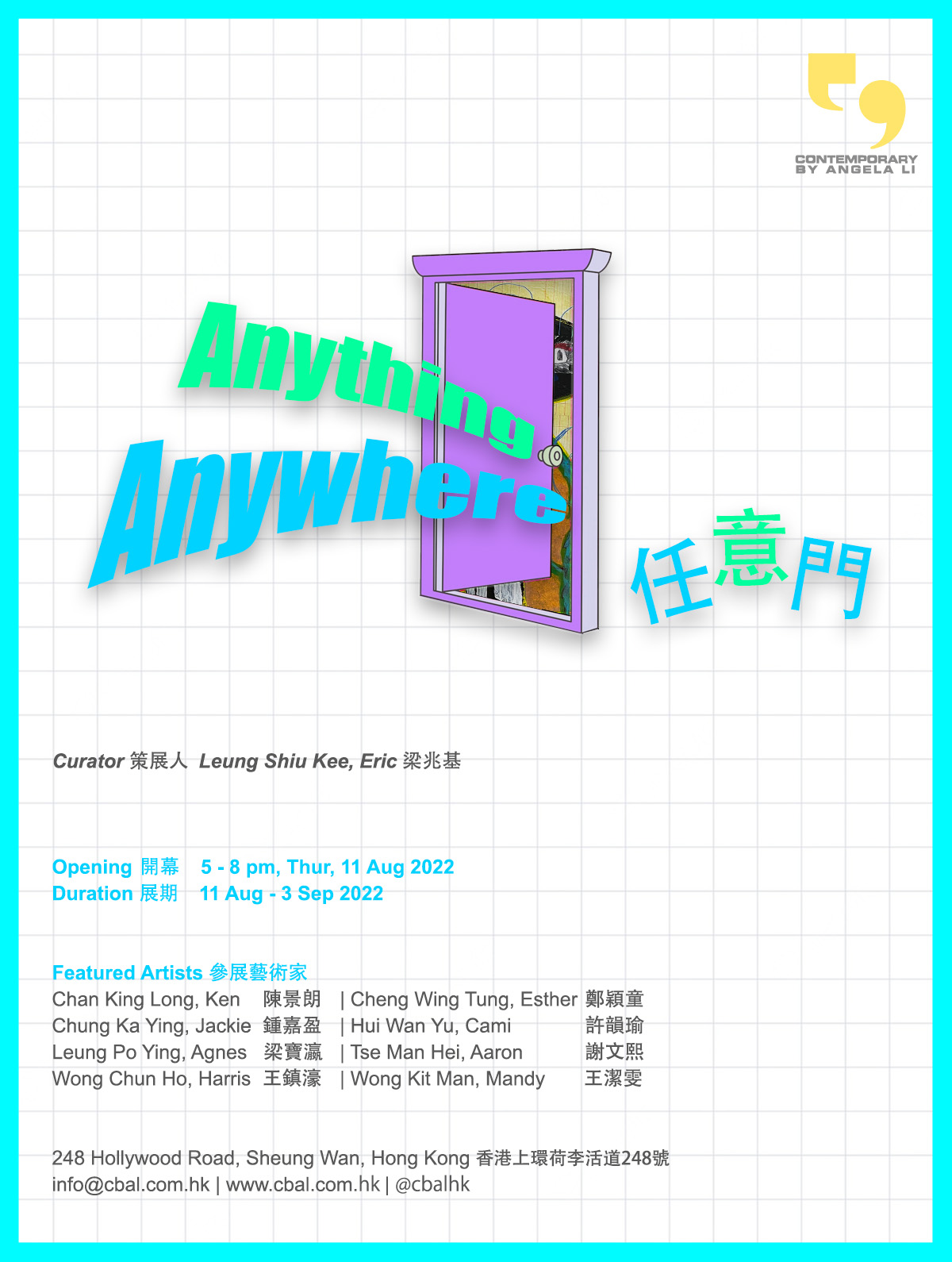

The "Anywhere Door" is a famous magical gadget hailing from the popular TV series "Doraemon", it enables travel between any realm of imagination. Similarly, the creative process parallels the motion of opening the “Anywhere Door;” allowing the psyche to drift, as it enters a world of abstraction where thoughts and imagination fly - after all anything, and everything can serve as inspiration to galvanise one's creativity. For recent art school graduates that just made their debut, one can say they have made their first step into the “Anywhere Door” of infinite possibility — launching an enriching career intertwined with fantasy and reality.
Contemporary by Angela Li is proud to present a group exhibition curated by Leung Shiu Kee, Eric “Anything Anywhere” from August 11th, 2022 to September 3rd , 2022. The exhibition showcases the otherworldly and fascinating works from eight young Hong Kong artists, all recent graduates from various local institutes. Participating artists include Chan King Long Ken, Cheng Wing Tung Esther, Chung Ka Ying Jackie, Hui Wan Yu Cami, Leung Po Ying Agnes, Tse Man Hei Aaron, Wong Chun Ho Harris, and Wong Kit Man Mandy. Through their distinctive and unique ways of artistic expression, each artist brings a different perspective to the table.
Anything Anywhere
Group Exhibition
Chan King Long, Ken has a talent for reconstructing dreamlike scenes from the subconscious psyche through realistic brushwork. His works are a response to various societal phenomena and his view of the human experience. His works feature people with obscured features who are juxtaposed against a hyperrealistic background, presenting a real yet simultaneously confusing and striking atmosphere — an almost pseudo-reality.
Tse Man Hei, Aaron’s paintings convey a strange sense of tension by illustrating figures who have contorted into peculiar poses. Alluding to Tse’s previous painted series titled Lean On, the presented works in this exhibition, Ground Zero and Tippy Toes also use a male and a female figure as the subject of focus. They pose in the same position whilst situated on top of a khaki background, which ultimately forms a nonsensical image. Both figures within the painting are seen as static and tame, but a push pull relationship has been carefully sheathed in between them. Not only does this sculpt a composition that becomes difficult to comprehend, it also reflects what Tse feels towards the current state of society.
Wong Chun Ho, Harris utilises the ceramic medium to express his bizarre associations with various objects. He feels that humour is a crucial element of the creative process, hence why Wong tends to transform bland and mundane objects with a playful and comedic twist. This in turn constructs his unique aesthetic, which Wong utilises it to explore the perplexing and eccentric world. The presented ceramic piece, titled Totem (failed), acts as a comic metaphor that visualises endless failures stacked upon each other.
Leung Po Ying, Agnes focuses on experimenting with the malleability of layering and paper collage on top of canvas. By portraying mystifying creatures with a vibrant use of colour and a childlike lens, Leung is able to express her diverse and fantastic figmental headspace.
Chung Ka Ying, Jackie chooses to depict movie scenes as her attempt to channel personal thoughts and emotions into visual content, thus leading to her creation of the Connecting the Dots series - an amalgamation of visuals and words. During the painting process, Chung creates an imaginary space for herself; a framework for her own self-reflection and contemplation, enabling her to link the cues, hints, and experiences from her daily life.
Hui Wan Yu, Cami’s work often incorporates elements from quotidian occurrences or those from special events, in conjunction with fragments from history and her own imagination. She then constructs an isolated, surreal and personal domain which acts as a diary for her thoughts and experiences. The presented work The Spectator, is brimming with sentimentality as it investigates the emotional relationship between individuals and groups.
Cheng Wing Tung, Esther’s series, Flip the Page, attempts to recreate an imagined slice of family history. Through wood carving techniques, Cheng recreates several lost household items and proceeds to paint their aesthetic details. Cheng produces several vintage objects that are the product of multiple painted surfaces which come together to form a seemingly tangible object. Through realistic yet spurious objects, Cheng recalls her mirage-esque memories of previous encounters.
Wong Kit Man, Mandy’s painted series, Passerby, depicts the nightly scenery seen outside the moving bus’s window as her way to record the city. Being an onlooker sitting on the upper deck, Wong has traversed across the city for several hundred times. The view beyond the window may render as erratic, or ever-shifting even. However, contrary to observation, the city’s affairs have been predetermined. Through portraying the flowing impressions left by light, Wong captures the melancholy of a passer-by.